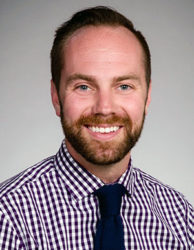
A large group of behavioral and social scientists, led by Dr. Cameron L. Randall of the University of Washington and Dr. Daniel W. McNeil of West Virginia University, are on a mission to throw the combined weight of their disciplines behind the effort to improve oral health globally.
“We’re trying to maximize the application of the behavioral and social sciences to oral health research and practice,” said Dr. Randall, a psychologist and member of the Department of Oral Health Sciences faculty at the School of Dentistry. “Are they being applied as robustly as possible, in the highest quality and most innovative ways?”
He and many of his colleagues think there’s substantial room for improvement in oral health research methods and in approaches to patients and the public in general.
“Because everyone’s oral health is strongly influenced by things like their environment, diet, health and oral hygiene behaviors, and access to and utilization of evidence-based interventions, there is much opportunity for impact if the behavioral and social sciences are fully tapped,” Dr. Randall said.
To that end, he and Dr. McNeil led the writing of a consensus statement for this movement that appeared Jan. 19 in the Journal of Dental Research, which is published by the International Association for Dental Research.
The statement, which has more than 400 endorsers, grew out of a three-day Behavioral and Social Oral Health Sciences Summit held in 2020. The virtual meeting, the first such international gathering of its kind, drew more than 400 people from 57 countries. After the meeting, the statement was produced with input from global stakeholders and several rounds of refinement. It reflects the current state of knowledge in the behavioral and social oral health sciences and identifies key future directions for the field.
Dr. Randall and his colleagues hope their efforts will spur broader conversations about translational science – which transforms discoveries into real-world practical applications – and multidisciplinary science, especially in dentistry and oral health.
“There is opportunity to better tap advances in disciplines such as psychology, sociology, economics, and political science,” he said. “We can tap innovations and current thinking in those areas and apply them to oral health interventions.”
Dentists and other oral health providers are prime targets for the movement. Dr. Randall noted that part of the consensus statement examines more immediate applications, such as clinicians’ use of innovative technology and person-centered approaches to promote behavioral change and prevent and treat dental disease.
He said, “We’re raising questions to be answered: What are the most effective behavioral interventions for patients? How can we motivate clinicians to quickly adopt these and other evidence-based interventions? How can we encourage them to use these approaches consistently?”
The target audience ranges well beyond dentists and other providers, too, he said. There’s a role for behavioral and social scientists to think about how to work with the community and community organizations to develop contextually appropriate oral health programs related to prevention and other goals.
He and his colleagues will also seek answers to this question: “How can behavioral and social scientists help develop structural changes to prevent dental disease and make oral health-care delivery more effective, accessible, and equitable?”
Even a seemingly unrelated field like economics can supply useful insights, Dr. Randall said, citing the example of taxing sugar to change consumer behavior. Research by Dr. Kristine Madsen of the University of California, Berkeley School of Public Health has found that taxes on sugar-sweetened beverages can significantly reduce their consumption, especially in low-income and diverse neighborhoods. These communities display the highest rates of obesity and diet-related chronic diseases such as diabetes and dental decay.
The next step for Dr. Randall and his colleagues will be addressing the gaps they’ve identified in current approaches to oral health research and interventions. “We’re asking people to fill those gaps,” he said. “We want the maximum impact for patients and providers alike. Thus, we want to make oral health researchers and other stakeholders aware of the consensus statement.”
The writers and endorsers of the statement hope the specific suggested future directions for research and its application will be good for science, patients, and communities, he said. Their aims are nothing if not ambitious. As Dr. Randall said: “This group is trying to determine what oral health equity looks like on a global scale and how to fully harness the behavioral and social sciences to help achieve it.”